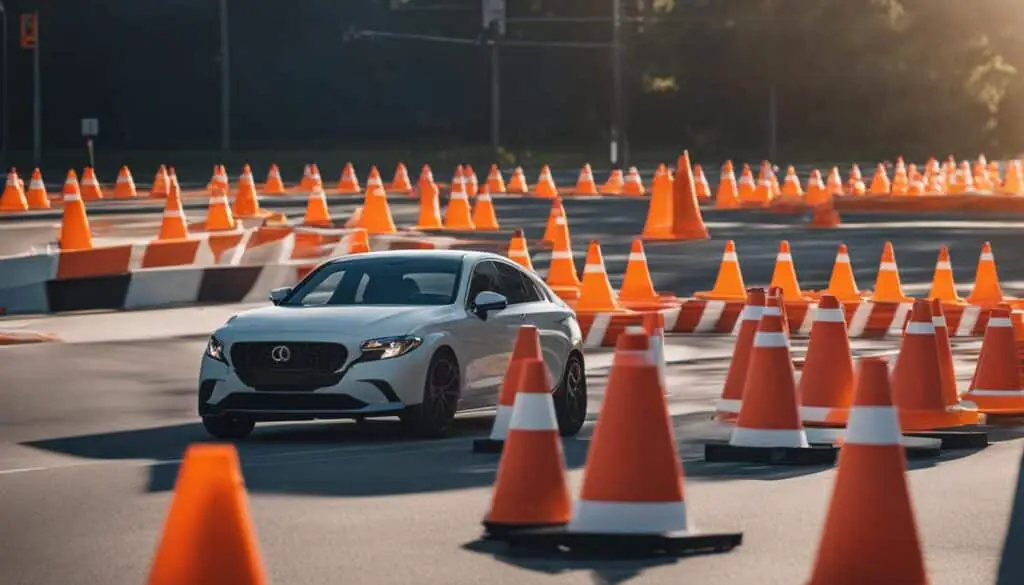
Advanced Driving Techniques for Better Car Control
As a driver, one of the most important skills to have is control over your vehicle. That’s where advanced driving techniques come in. These techniques can help you improve your car control skills and ensure safety on the roads, regardless of your experience level.
Whether you’re a beginner or an experienced driver, mastering advanced driving techniques can make a real difference in your driving abilities. In this section, we’ll explore a range of techniques that will give you greater control over your vehicle and improve your overall driving skills.
Key Takeaways:
- Advanced driving techniques can improve car control skills
- These techniques are valuable for drivers of all experience levels
- Mastering advanced driving techniques can enhance driving abilities and ensure safety on the roads
- Techniques such as weight transfer, traction control, and braking can help maneuver your car effectively
- Practicing defensive driving strategies like maintaining a safe following distance and scanning the road ahead can help avoid accidents
Mastering Vehicle Dynamics
As a driver, it’s important to understand the physics of your vehicle to master advanced driving techniques. Whether you’re a beginner or an experienced driver, knowing how your vehicle responds to different driving situations is key to improving your car control skills. In this section, we will explore some advanced driving techniques for beginners and experienced drivers that will help you to understand and apply vehicle dynamics to your driving.
Weight Transfer
Weight transfer is the concept of shifting the weight of your vehicle from one end to the other or from side to side. This technique is used to gain traction and control when accelerating, braking and cornering. For example, when accelerating from a stop, the weight of your vehicle will shift towards the rear. This results in less weight on the front wheels, causing them to lose grip and spin. To avoid this, gradually apply the gas and shift your weight towards the rear of your vehicle to maintain traction.
Traction Control
Traction control is a safety feature that helps prevent wheel spin when accelerating on slippery surfaces. It works by reducing engine power and applying the brakes to the spinning wheel until traction is regained. However, in some cases, turning off traction control can enhance your control of the vehicle. Experienced drivers know how to use traction control to their advantage by turning it off in situations where power is necessary, such as drifting or accelerating out of a corner.
Braking Techniques
Braking techniques are essential for controlling the speed and direction of your vehicle. Advanced driving techniques for braking include threshold braking, trail braking, and left-foot braking. Threshold braking is the practice of braking as hard as possible without locking up the wheels. Trail braking, on the other hand, involves gradually releasing the brakes as you turn into a corner, allowing you to carry more speed through the turn. Left-foot braking is a technique used in racing where the driver uses their left foot to brake while keeping their right foot on the accelerator. This allows for smoother transitions between accelerating and braking, improving overall car control.

“Remember, mastering vehicle dynamics takes time and practice. These advanced driving techniques go beyond the basics and require patience, skill, and dedication to perfect.”
Defensive Driving Strategies
As an experienced driver, I have learned firsthand the importance of defensive driving. Defensive driving techniques can help you stay focused, anticipate potential hazards, and avoid accidents. Here are some advanced driving tips to help you drive safely:
Maintain a safe following distance
One of the most important defensive driving techniques is to maintain a safe following distance between you and the car in front of you. By keeping a safe distance, you’ll have more time to react if the car in front of you suddenly slows down or stops. The general rule of thumb is to keep at least one car length for every 10 mph you’re driving.
Scan the road ahead
Another useful technique is to scan the road ahead. This means looking beyond the car in front of you and observing the traffic and surroundings. By scanning the road ahead, you can anticipate potential hazards like pedestrians, animals, or debris on the road.
Anticipate potential hazards
Anticipating potential hazards is another important defensive driving skill. You should always be aware of your surroundings and anticipate how other drivers may react. For example, if you see a car on the side of the road with its hazard lights on, you should slow down and be prepared for the possibility that the driver may suddenly pull out into traffic.
Minimize distractions
Distracted driving is a major cause of accidents. To minimize distractions, you should avoid using your phone while driving, keep the radio volume at a reasonable level, and avoid eating or drinking while driving. By minimizing distractions, you’ll be able to focus your attention on the road and react more quickly to potential hazards.
By implementing these advanced driving techniques, you’ll be able to stay safe and avoid accidents on the road. Remember to always stay alert and practice defensive driving every time you get behind the wheel.

Conclusion
As a professional driver, I have learned that advanced driving techniques are essential for improving car control and maintaining safety on the roads. By implementing these techniques, you can confidently handle any driving situation that may arise.
Remember to always practice these techniques in a controlled environment, such as an empty parking lot or closed track, to ensure you are comfortable and familiar with them.
Mastering advanced driving techniques takes time and practice, but it is a valuable skill that can greatly enhance your driving abilities. Whether you are a beginner or an experienced driver, these techniques will help you to stay alert, react quickly, and avoid accidents.
So, take the time to learn and practice these advanced driving techniques, and you’ll be well on your way to becoming a safer and more confident driver on the road.
Thank you for reading!
FAQ
What are some advanced driving techniques for better car control?
Advanced driving techniques such as smooth steering inputs, proper hand placement on the steering wheel, and using the correct braking techniques can greatly improve car control.
How can I master vehicle dynamics through advanced driving techniques?
Understanding concepts like weight transfer, traction control, and mastering techniques like trail braking and throttle control can help you become more proficient in controlling your vehicle.
What are some defensive driving strategies that can enhance safety?
Defensive driving strategies like maintaining a safe following distance, scanning the road ahead for potential hazards, and anticipating other drivers’ actions can greatly improve safety on the road.
Why should I learn advanced driving techniques?
Mastering advanced driving techniques can greatly improve your car control skills, enhance safety, and give you the confidence to handle different driving situations with precision.
Are these advanced driving techniques suitable for beginners?
Yes, beginners can benefit from learning and practicing advanced driving techniques. It is important to start with the basics and gradually progress to more advanced techniques as your skill level improves.
Should I practice these techniques in a controlled environment?
Yes, it is highly recommended to practice advanced driving techniques in a controlled environment such as a closed circuit or an empty parking lot. This allows you to familiarize yourself with the techniques and build confidence before applying them on public roads.
